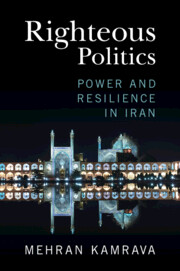Book contents
- Righteous Politics
- Righteous Politics
- Copyright page
- Contents
- Tables
- Preface
- 1 Introduction
- 2 Authoritarian Perseverance
- 3 Ruling under Stress
- 4 The Constitution, Elections, and Legitimacy
- 5 Elected Institutions
- 6 The Unelected Leadership
- 7 The Praetorians
- 8 Maintaining the System
- 9 The Deep State
- 10 Intra-elite Dynamics
- 11 The State and Its Riches
- 12 Conclusion
- Appendix
- Select Bibliography
- Index
3 - Ruling under Stress
Published online by Cambridge University Press: 10 August 2023
- Righteous Politics
- Righteous Politics
- Copyright page
- Contents
- Tables
- Preface
- 1 Introduction
- 2 Authoritarian Perseverance
- 3 Ruling under Stress
- 4 The Constitution, Elections, and Legitimacy
- 5 Elected Institutions
- 6 The Unelected Leadership
- 7 The Praetorians
- 8 Maintaining the System
- 9 The Deep State
- 10 Intra-elite Dynamics
- 11 The State and Its Riches
- 12 Conclusion
- Appendix
- Select Bibliography
- Index
Summary
There are three broad categories of challenges faced by the Islamic Republic state, namely those emanating from the inside, those exerted on the state from the outside, and those arising from the fraying of the state’s relations with society. In each instance, the state has been able to neutralize any potential threats coming its way through a resourceful combination of foreign policy adjustments, heightened repression, and expansive securitization. Ironically, the comprehensive and punishing sanctions imposed on the state from abroad have only helped further erode the purchasing power of Iranians and have narrowed prospects for international exchanges and globalization. The outcome has been a further strengthening of the state and especially hard-line factions within it, along with a steady disempowering of civil society and increased costs of political opposition. Sanctions have weakened Iranian society and strengthened the state.
Keywords
- Type
- Chapter
- Information
- Righteous PoliticsPower and Resilience in Iran, pp. 37 - 71Publisher: Cambridge University PressPrint publication year: 2023

